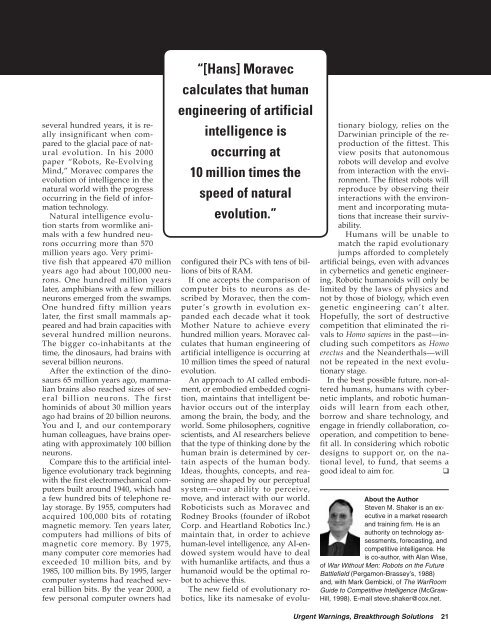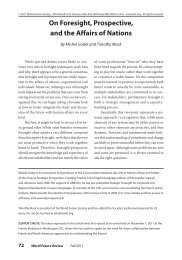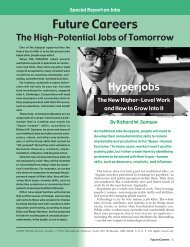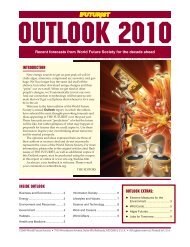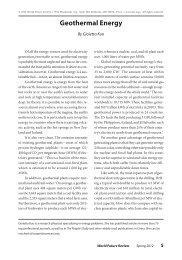Urgent Warnings, Breakthrough Solutions, Second Edition
Urgent Warnings, Breakthrough Solutions, Second Edition
Urgent Warnings, Breakthrough Solutions, Second Edition
Create successful ePaper yourself
Turn your PDF publications into a flip-book with our unique Google optimized e-Paper software.
configured their PCs with tens of billions<br />
of bits of RAM.<br />
If one accepts the comparison of<br />
computer bits to neurons as described<br />
by Moravec, then the computer<br />
’s growth in evolution expanded<br />
each decade what it took<br />
Mother Nature to achieve every<br />
hundred million years. Moravec calculates<br />
that human engineering of<br />
artificial intelligence is occurring at<br />
10 million times the speed of natural<br />
evolution.<br />
An approach to AI called embodiment,<br />
or embodied embedded cognition,<br />
maintains that intelligent behavior<br />
occurs out of the interplay<br />
among the brain, the body, and the<br />
world. Some philosophers, cognitive<br />
scientists, and AI researchers believe<br />
that the type of thinking done by the<br />
human brain is determined by certain<br />
aspects of the human body.<br />
Ideas, thoughts, concepts, and reasoning<br />
are shaped by our perceptual<br />
system—our ability to perceive,<br />
move, and interact with our world.<br />
Roboticists such as Moravec and<br />
Rodney Brooks (founder of iRobot<br />
Corp. and Heartland Robotics Inc.)<br />
maintain that, in order to achieve<br />
human-level intelligence, any AI-endowed<br />
system would have to deal<br />
with humanlike artifacts, and thus a<br />
humanoid would be the optimal robot<br />
to achieve this.<br />
The new field of evolutionary robotics,<br />
like its namesake of evoluseveral<br />
hundred years, it is really<br />
insignificant when compared<br />
to the glacial pace of natural<br />
evolution. In his 2000<br />
paper “Robots, Re-Evolving<br />
Mind,” Moravec compares the<br />
evolution of intelligence in the<br />
natural world with the progress<br />
occurring in the field of information<br />
technology.<br />
Natural intelligence evolution<br />
starts from wormlike animals<br />
with a few hundred neurons<br />
occurring more than 570<br />
million years ago. Very primitive<br />
fish that appeared 470 million<br />
years ago had about 100,000 neurons.<br />
One hundred million years<br />
later, amphibians with a few million<br />
neurons emerged from the swamps.<br />
One hundred fifty million years<br />
later, the first small mammals appeared<br />
and had brain capacities with<br />
several hundred million neurons.<br />
The bigger co-inhabitants at the<br />
time, the dinosaurs, had brains with<br />
several billion neurons.<br />
After the extinction of the dinosaurs<br />
65 million years ago, mammalian<br />
brains also reached sizes of several<br />
billion neurons. The first<br />
hominids of about 30 million years<br />
ago had brains of 20 billion neurons.<br />
You and I, and our contemporary<br />
human colleagues, have brains operating<br />
with approximately 100 billion<br />
neurons.<br />
Compare this to the artificial intelligence<br />
evolutionary track beginning<br />
with the first electromechanical computers<br />
built around 1940, which had<br />
a few hundred bits of telephone relay<br />
storage. By 1955, computers had<br />
acquired 100,000 bits of rotating<br />
magnetic memory. Ten years later,<br />
computers had millions of bits of<br />
magnetic core memory. By 1975,<br />
many computer core memories had<br />
exceeded 10 million bits, and by<br />
1985, 100 million bits. By 1995, larger<br />
computer systems had reached several<br />
billion bits. By the year 2000, a<br />
few personal computer owners had<br />
“[Hans] Moravec<br />
calculates that human<br />
engineering of artificial<br />
intelligence is<br />
occurring at<br />
10 million times the<br />
speed of natural<br />
evolution.”<br />
tionary biology, relies on the<br />
Darwinian principle of the reproduction<br />
of the fittest. This<br />
view posits that autonomous<br />
robots will develop and evolve<br />
from interaction with the environment.<br />
The fittest robots will<br />
reproduce by observing their<br />
interactions with the environment<br />
and incorporating mutations<br />
that increase their survivability.<br />
Humans will be unable to<br />
match the rapid evolutionary<br />
jumps afforded to completely<br />
artificial beings, even with advances<br />
in cybernetics and genetic engineering.<br />
Robotic humanoids will only be<br />
limited by the laws of physics and<br />
not by those of biology, which even<br />
genetic engineering can’t alter.<br />
Hopefully, the sort of destructive<br />
competition that eliminated the rivals<br />
to Homo sapiens in the past—including<br />
such competitors as Homo<br />
erectus and the Neanderthals—will<br />
not be repeated in the next evolutionary<br />
stage.<br />
In the best possible future, non-altered<br />
humans, humans with cybernetic<br />
implants, and robotic humanoids<br />
will learn from each other,<br />
borrow and share technology, and<br />
engage in friendly collaboration, cooperation,<br />
and competition to benefit<br />
all. In considering which robotic<br />
designs to support or, on the national<br />
level, to fund, that seems a<br />
good ideal to aim for.<br />
❑<br />
About the Author<br />
Steven M. Shaker is an executive<br />
in a market research<br />
and training firm. He is an<br />
authority on technology assessments,<br />
forecasting, and<br />
competitive intelligence. He<br />
is co-author, with Alan Wise,<br />
of War Without Men: Robots on the Future<br />
Battlefield (Pergamon-Brassey’s, 1988)<br />
and, with Mark Gembicki, of The WarRoom<br />
Guide to Competitive Intelligence (McGraw-<br />
Hill, 1998). E-mail steve.shaker@cox.net.<br />
<strong>Urgent</strong> <strong>Warnings</strong>, <strong>Breakthrough</strong> <strong>Solutions</strong> 21


